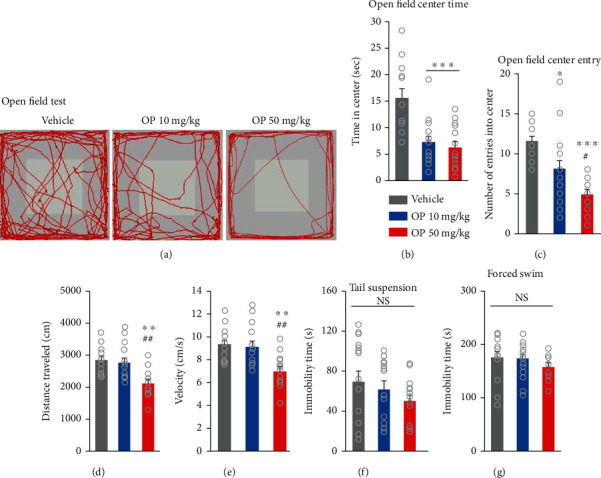Figure 7.

OP impairs locomotor activity, anxiety-like behavior, and nesting behavior in mice. (a) Representative tracing of mouse travel in the open field test. (b–e) Quantification of (a). The OP-treated groups displayed markedly reduction in both open field center time (F2,37 = 11.69, p = 0.0001) and open field center entry compared to the vehicle group (F2,39 = 14.54, p < 0.0001). The OP 50 mg/kg group showed fewer time entry to center compared to the OP 10 mg/kg group. In addition, the OP 50 mg/kg group exhibited significant lower in distance traveled (F2,38 = 9.004, p = 0.0006) and velocity in open field compared to both the vehicle group (F2,38 = 8.996, p = 0.0006). n = 18 mice (9 males, 9 females) for vehicle, 18 mice (9 males, 9 females) for OP 10 mg/kg, 15 mice (8 males, 7 females) for OP 50 mg/kg. Statistical significance was determined by one-way ANOVA with Bonferroni correction. ∗p < 0.05 and ∗∗p < 0.01 vs. vehicle, ∗∗∗p < 0.001 vs. vehicle, #p < 0.05 OP 10 mg/kg vs. OP 50 mg/kg, ##p < 0.01 OP 10 mg/kg vs. OP 50 mg/kg. (f) In tail suspension test, the OP-treated groups display no significant change in the immobility times compared to the vehicle group (F2,38 = 1.122, p = 0.3361). (g) In forced swimming test, there was no difference in the immobility times between vehicle- and OP-treated groups (F2,41 = 0.9785, p = 0.3845). n = 14 mice (7 males, 7 females) for vehicle, 15 mice (8 males, 7 females) for OP 10 mg/kg, 12 mice (7 males, 5 females) for OP 50 mg/kg. Data represent mean ± SEM. Statistical significance was determined by one-way ANOVA with Bonferroni correction. NS: no significance.
